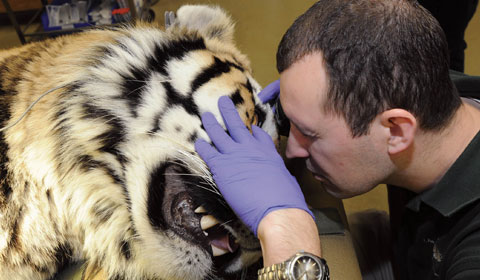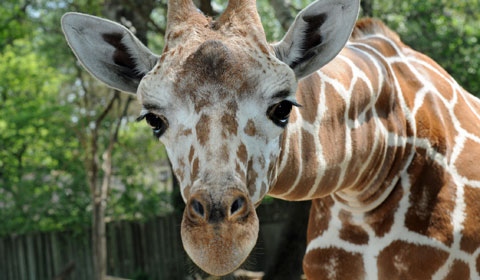News Release
Contact: Sondra Katzen, Public Relations, 708.688.8351, sondra.katzen@czs.org
August 22, 2018
FOR IMMEDIATE RELEASE
Note: Images of a pangolin may be downloaded below:
Pangolin_8339.jpg
Pangolin_8327.jpg
Pangolin_8337.jpg
Chicago Zoological Society Hosts International Symposium on
Pangolin Care and Conservation to help save the World’s Most Trafficked Mammal
Brookfield, Ill. – The Chicago Zoological Society, which manages Brookfield Zoo, is hosting animal care specialists and experts from across the world in pangolin research, conservation, and rehabilitation for the first International Symposium on Pangolin Care and Conservation. Beginning today, August 22, to Saturday, August 25, attendees will take part in discussions and informative and focused programming to explore integrative research and collaborative efforts and strategies to help save these threatened animals.
More than 50 attendees from around the world, including the United States, Nigeria, the United Kingdom, Taiwan, Togo, Ivory Coast, India, Vietnam, and the Czech Republic, will be discussing the latest scientific findings, conservation efforts, and pangolin husbandry. Participants will also hear from several keynote speakers, including Dr. Tina Chen, veterinarian, and Flora Lo, curator, who are both from Taipei Zoo, and Dr. Olajumoke Morenikeji, associate professor at the University of Ibadan in Nigeria and president of The Nigerian Association of Zoological Gardens and Wildlife Parks, who has played a vital role in challenging law enforcement agencies to protect and preserve the pangolin population.
In addition, experts who have directly cared for, studied, or are active in pangolin conservation programs will present their science-based abstracts at the symposium. Topics include: “Integrating Genetics into Conservation and Management of African White-Bellied Pangolins,” “Pangolin Husbandry Record-Keeping Data Base,” “Distribution and Conservation Status of Pangolins in Bangladesh: Filling the Knowledge Gap,” and “Market Survey and Population Characteristics of Three Species of Pangolins (Pholidota) in the Republic of the Congo.”
During the symposium, attendees also will meet in smaller working group sessions that focus on combatting wildlife trafficking, understanding pangolin taxonomy and genetics, conservation education to promote people’s behavior change, the roles and collaborative efforts of the ex-situ (under professionally managed care) population, genetic research issues and recommendations, and research to better understand in-situ (wild) status and threats.
In addition to sharing information about pangolin conservation, organizers anticipate one of the outcomes from the conference to be the development of a master plan for managed populations of the species as well as a messaging strategy for education and about ex-situ populations’ involvement in conservation.
“We hope that the synergy created by experts at the symposium will result in enhanced collaboration and improved management techniques for pangolins both in the wild and in professional care,” said Bill Zeigler, senior vice president of animal programs for the Chicago Zoological Society. “As a collective group, we have the capability, and definitely the passion, to make a difference for the pangolin’s future.”
Four species of pangolins are native to Asia and four to Africa—and they are all facing extinction. Over the past 10 years, more than a million pangolins have been poached from the wild for food in the illegal bushmeat trade, for their use in Asian medicines, and for their scales, which are made into jewelry. Efforts to prevent uncontrolled poaching have failed to reduce losses. The situation for pangolins has reached a critical level in Asia and will soon reach the same in Africa. In January 2017, the Convention on International Trade in Endangered Species of Wild Flora and Fauna (CITES) declared all eight species of pangolins endangered.
The plight of these animals spurred six zoological institutions in the United States, including the Chicago Zoological Society, and one private nonprofit organization into taking action. In 2014, they formed the Pangolin Consortium, which is working to establish a sustainable population of white-bellied tree pangolins under professional care to aid in better understanding their behavior and physiology and to support field conservation efforts. As part of the Consortium’s efforts, since April 2016, Society staff have cared for several white-bellied tree pangolins at Brookfield Zoo. Guests can see one of the pangolins in the zoo’s Habitat Africa! The Forest.
In addition to the Society, Consortium members include Pittsburgh Zoo & PPG Aquarium, Essex County Turtle Back Zoo, Memphis Zoo, Columbus Zoo and Aquarium, Gladys Porter Zoo and the nonprofit organization Pangolin Conservation. Together, Consortium members reach more than 7.8 million guests a year with information about pangolins. Despite increased media and social media coverage of the illegal activities surrounding pangolins, most Americans are unfamiliar with these species and have little to no knowledge of the threats to their survival. Providing this information is important, as is helping people understand the role they can play in pangolin conservation. For more information about the Consortium, visit pangolinconsortium.org.
During the upcoming Symposium, the Consortium will be announcing several grants it is awarding to individuals and organizations that will go toward research and conservation of these species, both in the wild and in professional care.
Pangolins have a distinctive look with a cone-shaped head, a long prehensile (grasping) tail, and a body that is covered with sharp, artichoke-shaped scales made of keratin. Often referred to as scaly anteaters, pangolins have the same long, muscular tongue as anteaters, covered with sticky saliva used to scoop up ants and termites. Adult pangolins can eat up to 20,000 ants and termites a day, adding up to 7.3 million ants and termites in one year. They are solitary animals, with males and females coming together for mating. Females give birth to a single baby. A baby’s scales are soft but begin to harden within days of its birth. Young pangolins do not walk for several weeks but cling to their mother’s tail to get around. At approximately four to six months of age, they are weaned and ready to be on their own.
# # #
About the Chicago Zoological Society
The mission of the Chicago Zoological Society is to inspire conservation leadership by engaging people and communities with wildlife and nature. The Chicago Zoological Society is a private nonprofit organization that operates Brookfield Zoo on land owned by the Forest Preserves of Cook County. The Society is known throughout the world for its international role in animal population management and wildlife conservation. Its Center for the Science of Animal Care and Welfare is at the forefront of animal care that strives to discover and implement innovative approaches to zoo animal management. Brookfield Zoo is the first zoo in the world to be awarded the Humane Certified™ certification mark for the care and welfare of its animals, meeting American Humane Association’s rigorous certification standards. Open every day of the year, the zoo is located at 8400 31stStreet in Brookfield, Illinois, between the Stevenson (I-55) and Eisenhower (I-290) expressways and is also accessible via the Tri-State Tollway (I-294), Metra commuter line, CTA and PACE bus service. For further information, visit CZS.org.
MEDIA CONTACT:
Sondra Katzen
Media Relations Manager
Office: 708-688-8351
Cell Phone: 708-903-2071
E-mail: Sondra.Katzen@CZS.org

Read about our innovative practices in animal welfare to ensure the ultimate care of our individual animals.

Create extraordinary connections with animals and nature!

Become our partner in caring for animals and in connecting people with wildlife and nature.